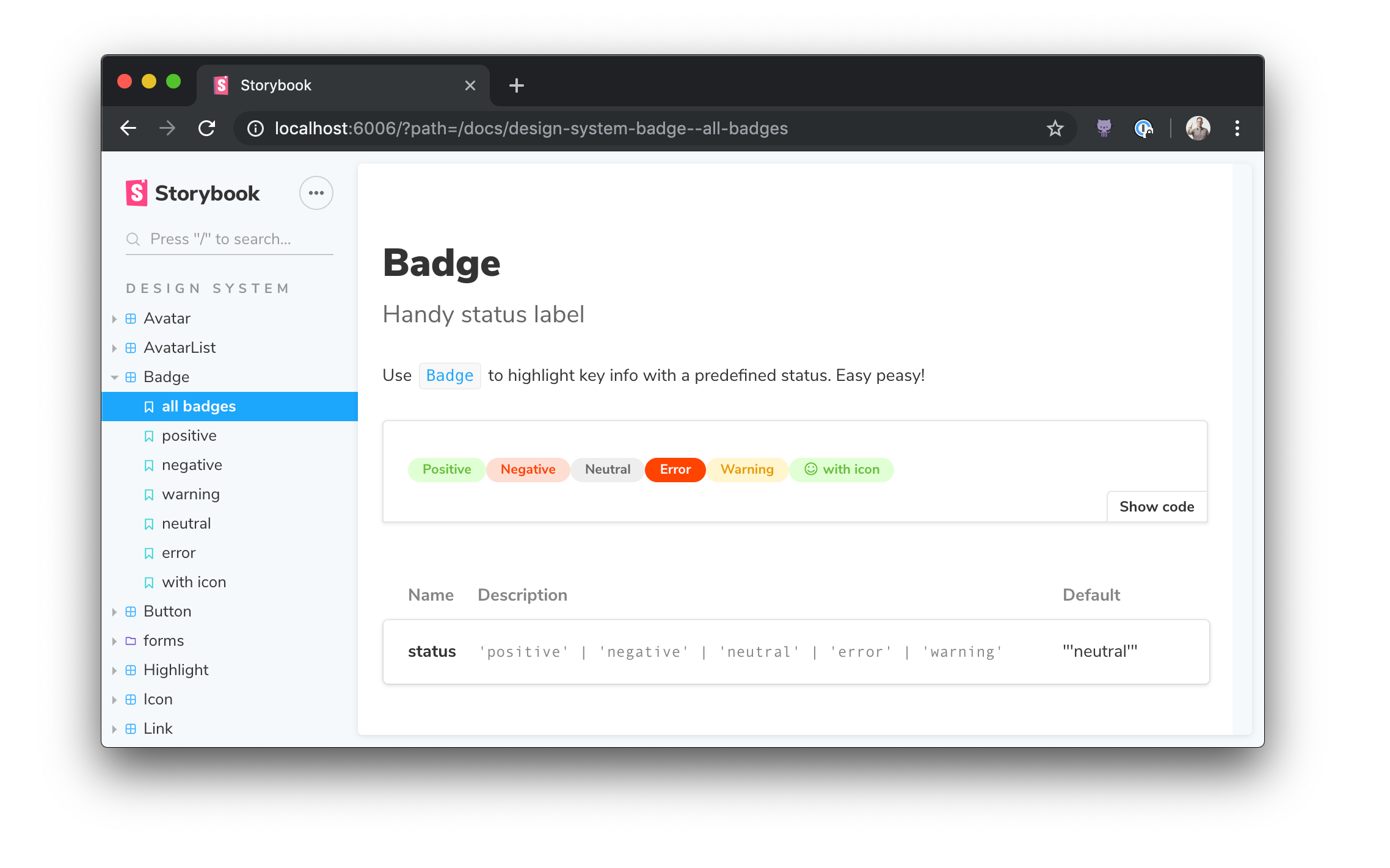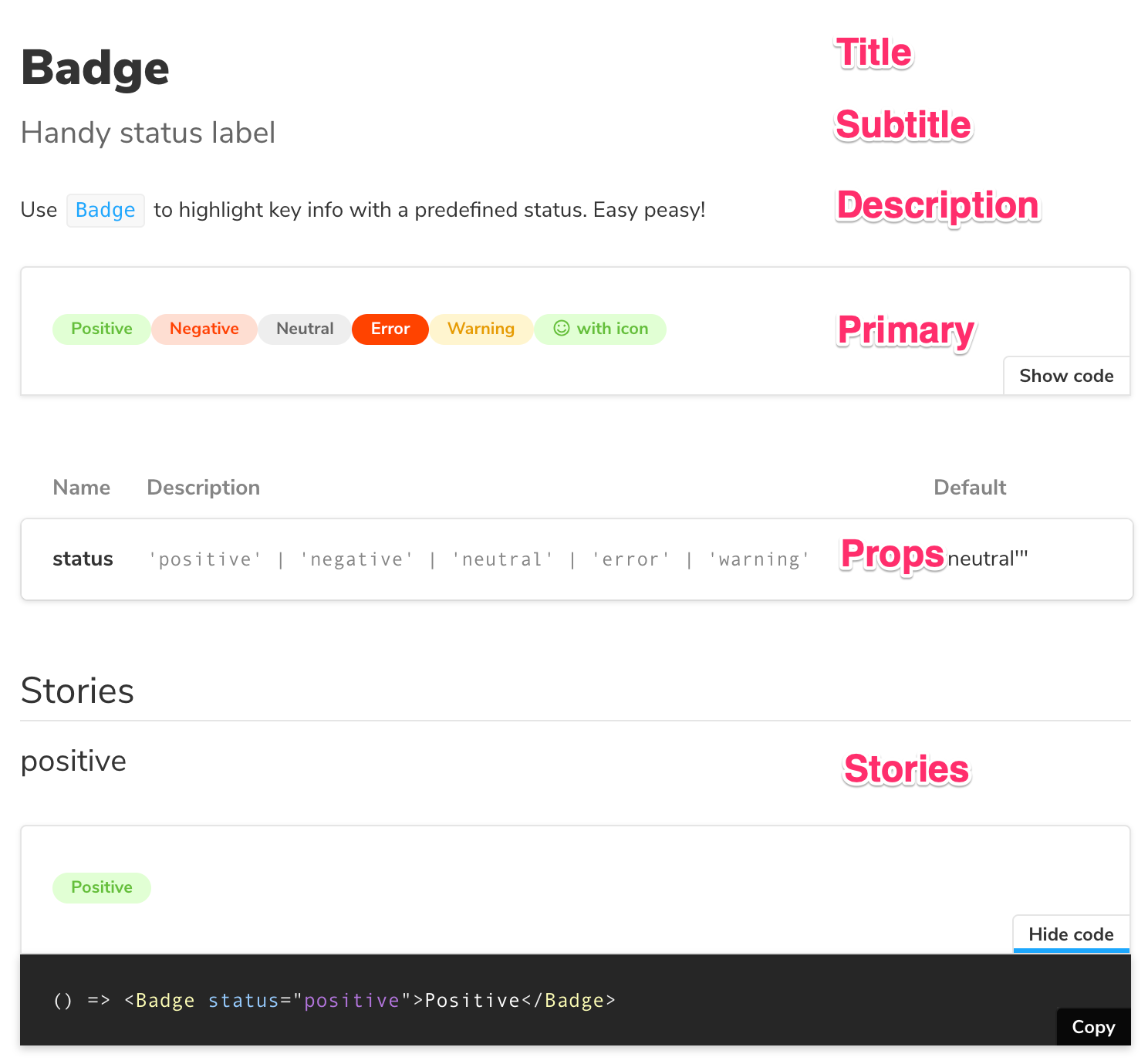13 KiB

Storybook DocsPage
When you install Storybook Docs, DocsPage is the zero-config default documentation that all stories get out of the box. It aggregates your stories, text descriptions, docgen comments, props tables, and code examples into a single page for each component.
Motivation
DocsPage is the successor to addon-info, which was one of the most popular Storybook addons despite many limitations.
Like addon-info, DocsPage provides sensible defaults, meaning it adds documentation to your existing Storybook without requiring any additional work on your part.
However, DocsPage brings the following improvements:
- It supports all frameworks that Storybook supports, including React, Vue, Angular and many others.
- It generates better documentation that can be used as a standalone docs site, independently of Storybook.
- It supports better configuration, so you can capture project specific information with ease.
- It's built to work with
MDXwhen you need more control of your documentation.
Component parameter
DocsPage pulls info from many sources, but one of the main ones is the component parameter, which is a new addition to Storybook in 5.2. It's based on the best practice that each component should have an associated set of documentation and stories (versus organizing it in some other way).
Storybook uses component to extract the component's description and props, and will rely on it further in future releases. We encourage you to add it to existing stories and use it in all new stories.
Here's how to set the component in Component Story Format (CSF):
import { Badge } from './Badge';
export default {
title: 'Path/to/Badge',
component: Badge,
};
And here's how to do the same thing the underlying storiesOf API:
import { storiesOf } from '@storybook/react';
import { Badge } from './Badge';
storiesOf('Path/to/Badge', module).addParameters({ component: Badge });
If you're coming from the storiesOf format, there's a codemod that adds it for you.
Subcomponents parameter
Sometimes it's useful to document multiple components on the same page. For example, suppose your component library contains List and ListItem components that don't make sense without one another. DocsPage has the concept of a "primary" component with the component parameter, and can also accept one or more "subcomponents":
import { List, ListHeading, ListItem } from './List';
export default {
title: 'Path/to/List',
component: List,
subcomponents: { ListHeading, ListItem },
};
Subcomponent prop tables will show up in a tabbed interface along with the primary component, and the tab titles will correspond to the keys of the subcomponents object.

If you want organize your documentation differently for groups of components, we recommend trying MDX which is completely flexible to support any configuration.
DocsPage slots
DocsPage is organized into a series of "slots" including Title, Subtitle, Description, Props, and Story. Each of these slots pulls information from your project and formats it for the screen.

Slot values
Each of the slots is computed by a built-in function, that can also be overridden using Slot Function.
Here is a summary of the slots, where the data comes from by default, and the slot function that can be used to override it:
| Slot | Default source | Slot function | Frameworks |
|---|---|---|---|
| Title | component title |
titleSlot |
All |
| Subtitle | componentSubtitle parameter |
subtitleSlot |
All |
| Description | component docgen comment |
descriptionSlot |
React, Vue |
| Primary | storybook stories | primarySlot |
All |
| Props | component docgen props or propTypes | propsSlot |
React, Vue |
| Stories | storybook stories | storiesSlot |
All |
The storiesSlot uses the docs.storyDescription parameter to show a description for each story, if available.
For more information on frameworks, see "Framework support"
Title
Title is computed from the component's title, and matches the component caption in Storybook's navigation.
For example:
export default {
title: 'Path/to/Badge',
};
Subtitle
The Subtitle slot is computed from the component's componentSubtitle parameter.
For example in Component Story Format (CSF):
export default {
...
parameters: {
componentSubtitle: 'Handy status label',
},
};
Description
The Description slot is computed from the Component's docgen comments in the component's source.
For example, here's the source for Badge:
/**
* Use `Badge` to highlight key info with a predefined status.
*/
export const Badge = ({ status, children }) => { ... }
Primary
The Primary slot is computed from the first user-defined story for the component.
For example here are Badge's stories in CSF. The allBadges is selected as the primary story because it's first:
// export default { ... }; /* Badge component metadata */
export const allBadges = () => ...
export const positive = () => ...
export const negative = () => ...
Props
The Props slot is computed from the component's docgen props, which can be defined in typescript or using react PropTypes.
For example, here are the PropTypes for the Badge component
import PropTypes from 'prop-types';
// ... Badge definition ...
Badge.propTypes = {
status: PropTypes.oneOf(['positive', 'negative', 'neutral', 'error', 'warning']),
};
Badge.defaultProps = {
status: 'neutral',
};
Stories
The Stories slot is computed from the user-defined stories for the component, excluding the first.
For example here are Badge's stories in CSF. The positive and negative stories are selected in that order:
// export default { ... }; /* Badge component metadata */
export const allBadges = () => ...
export const positive = () => ...
export const negative = () => ...
Slot functions
⚠️ Slot functions are an experimental feature in Storybook 5.2. The API may change in 5.3 outside of the normal semver rules. Be forewarned!
The value for each slot is computed from a SlotContext context, and the function that's used to compute the value can be overridden if you need to customize the page. If you find yourself doing a lot of configuration, or wanting different configurations for different pages, you might be better off using MDX. Everything that DocsPage gives you can be reconstructed in a few lines of MDX.
Here is the SlotContext type definition:
export interface SlotContext {
id?: string;
selectedKind?: string;
selectedStory?: string;
parameters?: any;
storyStore?: any;
}
And here are the return type signatures for each of the slot functions
| Slot | Function | Inputs | Output |
|---|---|---|---|
| Title | titleSlot | SlotContext |
string? |
| Subtitle | subtitleSlot | SlotContext |
string? |
| Primary | primarySlot | StoryData[], SlotContext |
StoryProps? |
| Props | propsSlot | SlotContext |
PropsTableProps? |
| Stories | storiesSlot | StoryData[], SlotContext |
StoryProps[]? |
Replacing DocsPage
What if you don't want a DocsPage for your storybook, for a specific component, or even for a specific story?
You can replace DocsPage at any level by overriding the docs.page parameter:
- With
nullto remove docs - With MDX docs
- With a custom React component
Globally (preview.js)
import { addParameters } from '@storybook/react';
addParameters({ docs: { page: null } });
Component-level (Button.stories.js)
import { Button } from './Button';
export default {
title: 'Demo/Button',
component: Button,
parameters: { docs: { page: null } },
};
Story-level (Button.stories.js)
import { Button } from './Button';
// export default { ... }
export const basic => () => <Button>Basic</Button>
basic.story = {
parameters: { docs: { page: null } }
}
Story file names
Unless you use a custom webpack configuration, all of your story files should have the suffix *.stories.[jt]sx?, e.g. "Badge.stories.js", "Badge.stories.tsx", etc.
The docs preset assumes this naming convention for its source-loader setup. If you want to use a different naming convention, you'll need a manual configuration.
Inline stories vs. Iframe stories
Due to the complex nature of writing a cross-framework utility like Storybook, the story blocks for most frameworks exist within an <iframe> element. This creates a clean separation of the context the code for each framework lives inside, but it isn't a perfect tradeoff. It does create a set of disadvantages--namely, you have to explicitly set the height of a story. It also causes some headaches for certain dev tools (Vue dev tools, for example, don't pick up components that exist in an iframe, without substantial jerry-rigging).
That being said, there is a system in place to remove the necessity of this tradeoff. The docs configuration contains two options, inlineStories and prepareForInline that can work together to integrate non-react stories seamlessly (or should I say "scroll-bar-less-ly") into DocsPage. Setting inlineStories to true tells storybook to stop putting your stories into an iframe. The hard(er) part is providing the prepareForInline parameter. This parameter accepts a function that transforms story content in your given framework into something react can render. Any given framework will need to approach this in a different way. Angular, for example, might convert its story content into a custom element (you can read about that here). We've actually taken the initiative and implemented Vue inline stories for you in the default docs config for Vue, because we're such nice people. The following docs config block allows Vue components to be rendered inline through an effect hook provided by @egoist/vue-to-react:
import React from 'react';
import { render } from 'react-dom';
import toReact from '@egoist/vue-to-react';
import { addParameters } from '@storybook/vue';
addParameters({
docs: {
prepareForInline: storyFn => {
const Story = toReact(storyFn());
return <Story />;
},
},
});
With that function, anyone using the docs addon for @storybook/vue can make their stories render inline, either globally with the inlineStories docs parameter, or on a per-story-basis using the inline prop on the <Story> doc block. If you come up with an elegant and flexible implementation for the prepareForInline function for your own framework, let us know! We'd love to make it the default configuration, to make inline stories more accessible for a larger variety of frameworks!
More resources
Want to learn more? Here are some more articles on Storybook Docs:
- References: README / MDX / FAQ / Recipes / Theming
- Vision: Storybook Docs sneak peak
- Announcement: DocsPage
- Example: Storybook Design System
- Technical preview guide